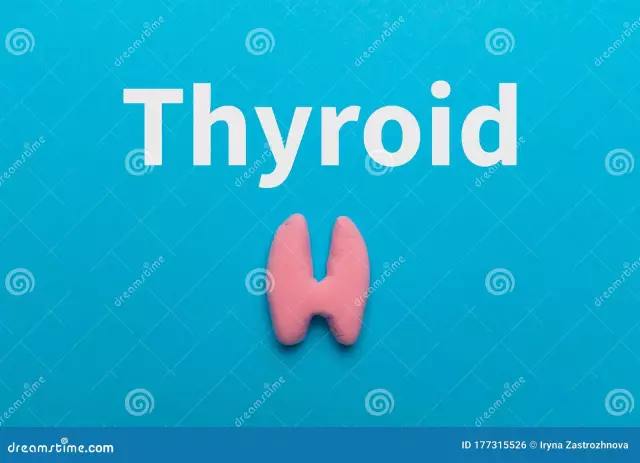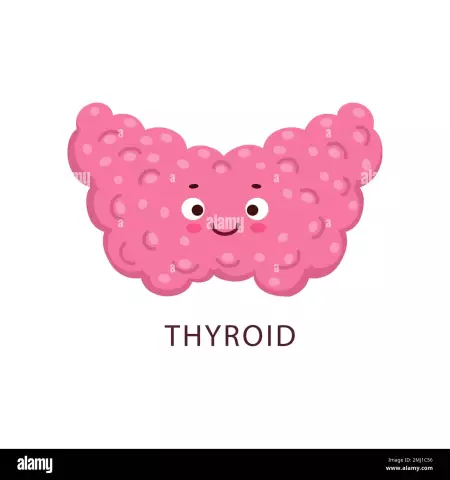- Author Rachel Wainwright [email protected].
- Public 2024-01-15 19:51.
- Last modified 2025-11-02 20:14.
Colloid cyst of the thyroid gland
The content of the article:
- Colloid cyst of the thyroid gland - what is it?
- Symptoms and Diagnosis
- Causes of occurrence
-
Treatment
- Surgical removal
- Thyroid surgery
- Possible complications after surgery
- Video
Colloid cyst of the thyroid gland, like others, different in morphological structure of the volumetric formations of the thyroid gland, is classified as a nodular goiter. In clinical practice, a node is understood as a tumor-like formation that has a capsule and is determined by palpation or using instrumental diagnostics.

Colloid cyst is a true thyroid cyst, but refers to the term nodular goiter, like other neoplasms
Colloid cyst of the thyroid gland - what is it?
Typical differences between colloid cysts and other forms:
- It has a cavity filled with a liquid serous component and covered with a dense fibrous capsule. It is extremely rare that the contents of the cyst are hemorrhagic (unfavorable sign). The cavity structure is often rounded.
- Has no tendency to grow or dissolve.
- It is extremely rarely malignant.
- The formation is solitary, located in the right or left lobe of the thyroid gland, the isthmus is rarely affected.
- Has limited mobility, since the wall is partially welded to the surrounding tissues.
- It is painless on palpation.
- The size varies widely (from small, which is not visualized, to large, causing severe neck deformity). Cysts up to 1 centimeter are not subject to surgical treatment.
Symptoms and Diagnosis
Symptoms occur when the cysts are large (more than 5 cm). Prior to this, the pathology is asymptomatic. Manifestations depend on the direction of growth - inward, which leads to compression of the structures in the throat, or outward with compression of the neurovascular bundle.
If a thyroid cyst is suspected, a consultation with an endocrinologist and an ultrasound scan is indicated in a planned manner (diagnostics every six months).
The prognosis for the patient is favorable.
Causes of occurrence
There are several contributing factors:
- Heredity. This factor applies to any neoplasms of the thyroid gland, both benign and malignant.
- Limited intake of iodine. In iodine-endemic geographic areas, the use of iodized salt, sea fish and seaweed is recommended.
- Inflammatory processes in the thyroid gland or its surrounding tissues.
- Traumatic injuries. In this case, the cyst is a post-traumatic formation (another nosological form that is not colloidal). In this case, a true cyst can form only long after the injury. A differential sign of the two diseases is the nature of the exudate in the cyst cavity (serous or hemorrhagic).
- Disorders of the endocrine system. We are talking about both dysfunction of thyroid hormones and a violation of the production of hormones of other endocrine organs (ovaries, adrenal glands, pituitary gland).
- An unhealthy lifestyle (violation of the daily routine, nutrition, excessive physical activity).
- X-ray exposure. This reason is important for workers in X-ray rooms, since a single exposure to a person (for example, for a professional examination once a year) does not cause cystic degeneration of tissues.
- Tobacco smoking. In this case, the tar and other components of cigarettes fill the ducts of the glands and disrupt their work (applies not only to the thyroid, but also to all endocrine glands).
There is no clear etiological reason for the development of tumor-like growths of the thyroid gland.
Treatment
When a node is found, a consultation is shown:
- endocrinologist;
- oncologist;
- oncosurgeon (in cases where the gland rapidly increases and disrupts the work of neighboring organs).
Treatment tactics will be directly dependent on the size of the cystic formation:
- less than 1 cm - only require observation;
- from 1 to 3 cm - amenable to conservative therapy (hormonal, iodine-containing drugs, anti-inflammatory);
- from 3 to 5 cm - planned surgical treatment (puncture, hardening);
- more than 5 cm - operations with partial removal of thyroid tissue.
Surgical removal
Indications for surgical treatment:
- the size;
- lack of effect from conservative therapy;
- fast growth;
- suspicion of malignancy (uneven contours, heterogeneous contents, compaction of regional lymph nodes, sprouting into neighboring structures);
- pronounced decompensation of the gland.
Surgical options are presented in the table.
| View | Method essence |
| Puncture | Using an aspiration needle under ultrasound control, fluid is removed |
| Sclerotherapy | Injection into the cavity of a sclerosing substance that sleeps the walls of the cyst |
| Thyroidectomy | Complete removal of the thyroid gland. It is rarely used and often with multinodular lesions of two lobes |
| Subtotal resection | Partial removal of gland tissue |
| Subtotal resection with removal of the isthmus | Partial removal of both lobes and the isthmus of the thyroid gland (no more than 1-1.5 ml of thyroid tissue remains) |
| Hemithyroidectomy with isthmus removal | Complete removal of one lobe and isthmus |
| Isthmus removal | Removing only the isthmus without affecting the lobes |
The choice of tactics depends on the individual characteristics of the tumor process.

Some thyroid cysts are removed by puncture
Thyroid surgery
The position is horizontal with the rollers in the interscapular zone and the head thrown back.
Anesthesia - intubation anesthesia.
Stages:
- Kocher collar section. It is carried out in an arcuate manner between the two sternocleidomastoid muscles, along the skin fold of the neck, 1-2 transverse fingers above the notch of the sternum. The length of the incision is selected according to the size of the tumor (cosmeticity is taken into account). The tissues are dissected in layers and pushed back in a blunt way up and down using hooks. Small vessels are ligated, and large ones are carefully removed from the operating field.
- The thyroid gland is mobilized into the wound after dissection of all the fascia of the neck. An audit is carried out in the space behind the thyroid gland and a decision is made regarding further operational tactics. Mobilization begins with the pyramidal process and the release of the anterior surface of the thyroid and cricoid cartilage, and then the lower pole. After ligation of the lower thyroid artery, the lower pole of the gland is released. During revision, they act extremely carefully in order not to damage the passing vessels and nerves in the tissue surrounding the thyroid gland.
- To avoid damage to the trachea, it is separated from the thyroid gland in a blunt way (using a Billroth clamp). Then all connective tissue cords around the gland are gradually crossed.
- If necessary, cytology or histology, first remove the part that will be used for the research data. Diagnostics is carried out in an emergency mode and, according to its results, the further course of the operation is determined.
- During the operation, it is necessary to remember about the presence of parathyroid glands behind the thyroid gland. If they are accidentally removed, the crushed parathyroid tissue is autotransplanted into the thickness of the neck muscles.
- Depending on the tactics, complete or partial removal of the remaining sections of the gland is performed. The amount of tissue that can be left is determined by the surgeon.
- A thorough hemostasis is achieved by bandaging / stitching. In the presence of bleeding areas (intersection of small vessels during the operation), ligation is indicated.
- At the end of the operation, drains are installed, and the wound is sutured in layers with a cosmetic suture on the skin.
In the postoperative period, a course of hormonal therapy is shown, which will be further corrected at the outpatient-polyclinic level (endocrinologist). Taking drugs for life.
Possible complications after surgery
- paresis and paralysis of the laryngeal nerves (unilateral or bilateral);
- hypothyroidism or hypoparathyroidism;
- tracheomalacia (damage to the trachea);
- bleeding;
- suppuration;
- ligature fistulas.
Complications are relatively common due to the extremely complex topographic structure and location of the thyroid gland relative to the surrounding tissues.
Video
We offer for viewing a video on the topic of the article.

Anna Kozlova Medical journalist About the author
Education: Rostov State Medical University, specialty "General Medicine".
The information is generalized and provided for informational purposes only. At the first sign of illness, see your doctor. Self-medication is hazardous to health!






